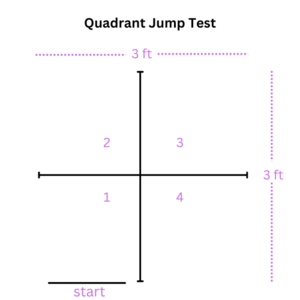Quadrant Jump Test: Difference between revisions
No edit summary |
No edit summary |
||
| Line 22: | Line 22: | ||
'''Disadvantages''': Only one person can perform the test at a time.<ref name=":0" /> | '''Disadvantages''': Only one person can perform the test at a time.<ref name=":0" /> | ||
'''Variations''' | |||
There's no standardised way of doing the test so there are differences in existing research: | |||
* Some studies use 15 seconds for each trial | |||
* Quadrant jumps may be performed | |||
* Comparison of performing the test in the anticlockwise and clockwise directions may show if any imbalances exist between left and right movement skills. | |||
* Scoring | |||
== Scoring == | == Scoring == | ||
* 1 point is given every time both feet land in the right quadrant | * 1 point is given every time both feet land in the right quadrant | ||
* 0.5 point subtracted every time the feet touch a line or | * 0.5 point is subtracted every time the feet touch a line or land in an incorrect quadrant. | ||
* There are 2 ways to compute the final score: | |||
** average of the 2 trials | |||
** best of 2 trials<ref name=":0" /><ref>Jakiwa J, Rustam S, Atan SA, Azli MS, Maliki AB, Nadzmi A, Rahman AF, Samsir MS, Sun Z, Kuo PT, Bee NC. The Effects of Multi-Sport Intervention on Agility Performance among Young Athletes. International Journal of Human Movement and Sports Sciences. 2023;11(4):864-71.</ref> | |||
== Evidence == | |||
There are limited studies measuring the validity and reliability of the Quadrant Jump | |||
== Reliability and validity of the Quadrant Jump Test == | == Reliability and validity of the Quadrant Jump Test == | ||
Revision as of 16:13, 17 June 2024
This article or area is currently under construction and may only be partially complete. Please come back soon to see the finished work! (17/06/2024)
Introduction[edit | edit source]
The Quadrant Jump Test is an agility test that measures an individual's ability to jump rapidly within a limited space while maintaining balance and control.[1]
Purpose[edit | edit source]
The Quadrant Jump Test is commonly used to test whole body agility of athletes from different sports.
Technique[edit | edit source]
Equipment: stopwatch, tape measure, chalk or tape
Instructions:
- Stand with both feet together at the starting line
- On the command 'go', jump into the first quadrant, then successively into quadrants 1, 2, 3, 4, 1, 2, and so on for 10 seconds.
- Rest
- Repeat the trial (Total of 2 trials are performed)
Advantages: Simple agility test to perform, requiring limited equipment and space.
Disadvantages: Only one person can perform the test at a time.[1]
Variations
There's no standardised way of doing the test so there are differences in existing research:
- Some studies use 15 seconds for each trial
- Quadrant jumps may be performed
- Comparison of performing the test in the anticlockwise and clockwise directions may show if any imbalances exist between left and right movement skills.
- Scoring
Scoring[edit | edit source]
- 1 point is given every time both feet land in the right quadrant
- 0.5 point is subtracted every time the feet touch a line or land in an incorrect quadrant.
- There are 2 ways to compute the final score:
Evidence[edit | edit source]
There are limited studies measuring the validity and reliability of the Quadrant Jump
Reliability and validity of the Quadrant Jump Test[edit | edit source]
- ↑ 1.0 1.1 1.2 Johnson, B.L.; Nelson, J.K. IN: Kirby, R. F. (1991). Kirby's guide to fitness and motor performance tests. BenOak Pub. Co. Cape Girardeau, MO. Page(s) 59-60.
- ↑ Jakiwa J, Rustam S, Atan SA, Azli MS, Maliki AB, Nadzmi A, Rahman AF, Samsir MS, Sun Z, Kuo PT, Bee NC. The Effects of Multi-Sport Intervention on Agility Performance among Young Athletes. International Journal of Human Movement and Sports Sciences. 2023;11(4):864-71.







